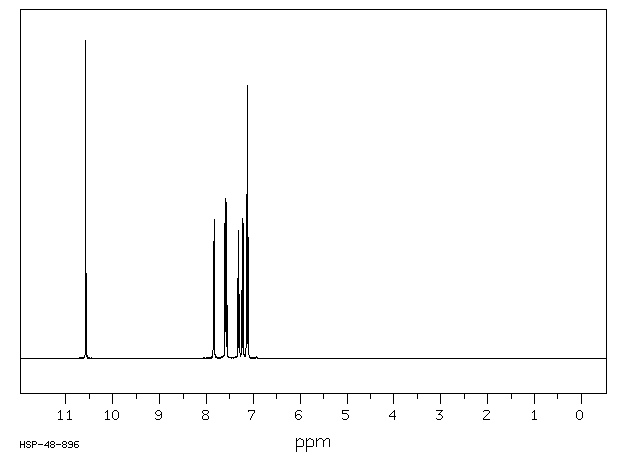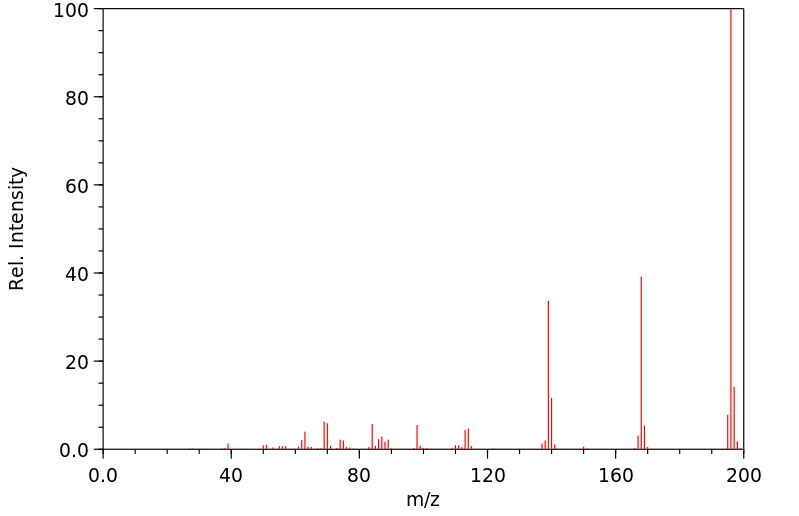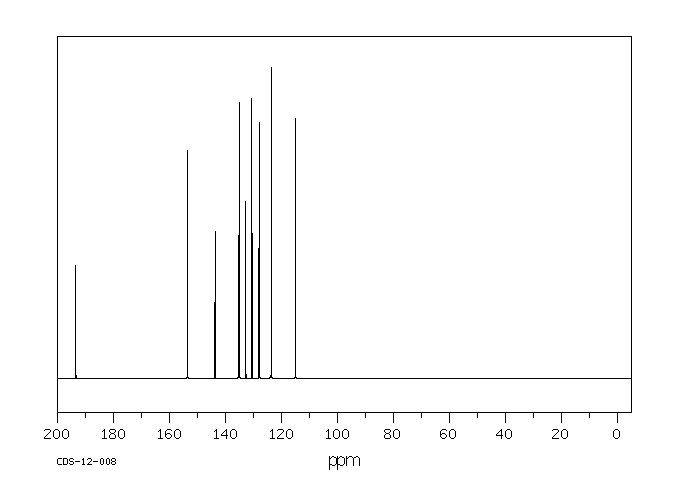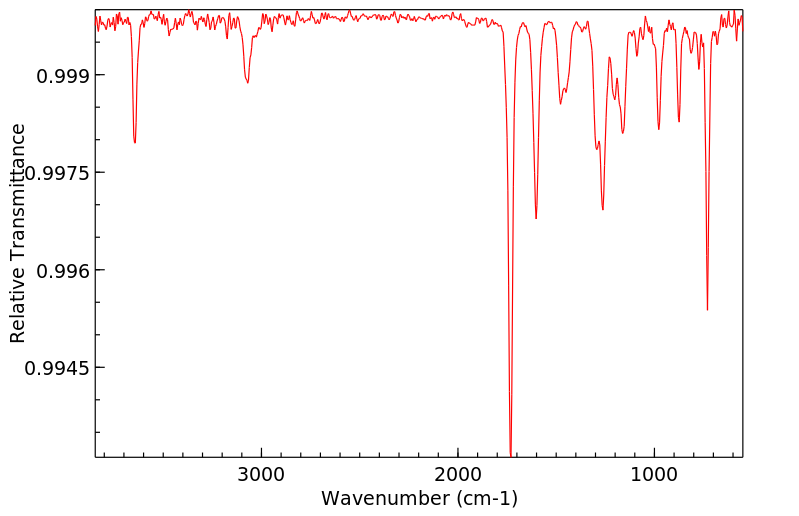4-羟基芴-9-酮 | 1986-00-1
中文名称
4-羟基芴-9-酮
中文别名
4-羟基-1-芴酮
英文名称
4-hydroxy-9-fluorenone
英文别名
4-hydroxy-9-oxofluorene;4-hydroxy-9H-fluoren-9-one;4-hydroxyfluorenone;4-hydroxyfluoren-9-one;4-hydroxy-fluoren-9-one;4-Hydroxy-fluoren-9-on
CAS
1986-00-1
化学式
C13H8O2
mdl
MFCD00001144
分子量
196.205
InChiKey
OZLKIIAMQWXVKQ-UHFFFAOYSA-N
BEILSTEIN
——
EINECS
——
-
物化性质
-
计算性质
-
ADMET
-
安全信息
-
SDS
-
制备方法与用途
-
上下游信息
-
文献信息
-
表征谱图
-
同类化合物
-
相关功能分类
-
相关结构分类
物化性质
-
LogP:3.140 (est)
-
熔点:250.0 °C
-
稳定性/保质期:
存在于主流烟气中。
计算性质
-
辛醇/水分配系数(LogP):2.7
-
重原子数:15
-
可旋转键数:0
-
环数:3.0
-
sp3杂化的碳原子比例:0.0
-
拓扑面积:37.3
-
氢给体数:1
-
氢受体数:2
安全信息
-
海关编码:2914501900
SDS
SECTION 1: Identification of the substance/mixture and of the company/undertaking
Product identifiers
Product name : 4-Hydroxy-9-fluorenone
REACH No. : A registration number is not available for this substance as the substance
or its uses are exempted from registration, the annual tonnage does not
require a registration or the registration is envisaged for a later
registration deadline.
CAS-No. : 1986-00-1
Relevant identified uses of the substance or mixture and uses advised against
Identified uses : Laboratory chemicals, Manufacture of substances
SECTION 2: Hazards identification
Classification of the substance or mixture
Classification according to Regulation (EC) No 1272/2008
Skin irritation (Category 2), H315
Eye irritation (Category 2), H319
Specific target organ toxicity - single exposure (Category 3), H335
For the full text of the H-Statements mentioned in this Section, see Section 16.
Classification according to EU Directives 67/548/EEC or 1999/45/EC
Xi Irritant R36/37/38
For the full text of the R-phrases mentioned in this Section, see Section 16.
Label elements
Labelling according Regulation (EC) No 1272/2008
Pictogram
Signal word Warning
Hazard statement(s)
H315 Causes skin irritation.
H319 Causes serious eye irritation.
H335 May cause respiratory irritation.
Precautionary statement(s)
P261 Avoid breathing dust/ fume/ gas/ mist/ vapours/ spray.
P305 + P351 + P338 IF IN EYES: Rinse cautiously with water for several minutes. Remove
contact lenses, if present and easy to do. Continue rinsing.
Supplemental Hazard none
Statements
Other hazards - none
SECTION 3: Composition/information on ingredients
Substances
Formula : C13H8O2
Molecular Weight : 196,20 g/mol
CAS-No. : 1986-00-1
Hazardous ingredients according to Regulation (EC) No 1272/2008
Component Classification Concentration
4-Hydroxy-9-fluorenone
Skin Irrit. 2; Eye Irrit. 2; STOT -
SE 3; H315, H319, H335
Hazardous ingredients according to Directive 1999/45/EC
Component Classification Concentration
4-Hydroxy-9-fluorenone
Xi, R36/37/38 -
For the full text of the H-Statements and R-Phrases mentioned in this Section, see Section 16
SECTION 4: First aid measures
Description of first aid measures
General advice
Consult a physician. Show this safety data sheet to the doctor in attendance.
If inhaled
If breathed in, move person into fresh air. If not breathing, give artificial respiration. Consult a physician.
In case of skin contact
Wash off with soap and plenty of water. Consult a physician.
In case of eye contact
Rinse thoroughly with plenty of water for at least 15 minutes and consult a physician.
If swallowed
Never give anything by mouth to an unconscious person. Rinse mouth with water. Consult a physician.
Most important symptoms and effects, both acute and delayed
The most important known symptoms and effects are described in the labelling (see section 2.2) and/or in
section 11
Indication of any immediate medical attention and special treatment needed
no data available
SECTION 5: Firefighting measures
Extinguishing media
Suitable extinguishing media
Use water spray, alcohol-resistant foam, dry chemical or carbon dioxide.
Special hazards arising from the substance or mixture
Carbon oxides
Advice for firefighters
Wear self contained breathing apparatus for fire fighting if necessary.
Further information
no data available
SECTION 6: Accidental release measures
Personal precautions, protective equipment and emergency procedures
Use personal protective equipment. Avoid dust formation. Avoid breathing vapors, mist or gas. Ensure
adequate ventilation. Evacuate personnel to safe areas. Avoid breathing dust.
For personal protection see section 8.
Environmental precautions
Do not let product enter drains.
Methods and materials for containment and cleaning up
Pick up and arrange disposal without creating dust. Sweep up and shovel. Keep in suitable, closed
containers for disposal.
Reference to other sections
For disposal see section 13.
SECTION 7: Handling and storage
Precautions for safe handling
Avoid contact with skin and eyes. Avoid formation of dust and aerosols.
Provide appropriate exhaust ventilation at places where dust is formed.Normal measures for preventive fire
protection.
For precautions see section 2.2.
Conditions for safe storage, including any incompatibilities
Store in cool place. Keep container tightly closed in a dry and well-ventilated place.
Specific end use(s)
A part from the uses mentioned in section 1.2 no other specific uses are stipulated
SECTION 8: Exposure controls/personal protection
Control parameters
Components with workplace control parameters
Exposure controls
Appropriate engineering controls
Handle in accordance with good industrial hygiene and safety practice. Wash hands before breaks and
at the end of workday.
Personal protective equipment
Eye/face protection
Safety glasses with side-shields conforming to EN166 Use equipment for eye protection tested
and approved under appropriate government standards such as NIOSH (US) or EN 166(EU).
Skin protection
Handle with gloves. Gloves must be inspected prior to use. Use proper glove removal technique
(without touching glove's outer surface) to avoid skin contact with this product. Dispose of
contaminated gloves after use in accordance with applicable laws and good laboratory practices.
Wash and dry hands.
The selected protective gloves have to satisfy the specifications of EU Directive 89/686/EEC and
the standard EN 374 derived from it.
Body Protection
Impervious clothing., The type of protective equipment must be selected according to the
concentration and amount of the dangerous substance at the specific workplace.
Respiratory protection
For nuisance exposures use type P95 (US) or type P1 (EU EN 143) particle respirator.For higher
level protection use type OV/AG/P99 (US) or type ABEK-P2 (EU EN 143) respirator cartridges.
Use respirators and components tested and approved under appropriate government standards
such as NIOSH (US) or CEN (EU).
Control of environmental exposure
Do not let product enter drains.
SECTION 9: Physical and chemical properties
Information on basic physical and chemical properties
a) Appearance Form: solid
b) Odour no data available
c) Odour Threshold no data available
d) pH no data available
e) Melting point/freezing Melting point/range: 249 - 251 °C
point
f) Initial boiling point and no data available
boiling range
g) Flash point no data available
h) Evaporation rate no data available
i) Flammability (solid, gas) no data available
j) Upper/lower no data available
flammability or
explosive limits
k) Vapour pressure no data available
l) Vapour density no data available
m) Relative density no data available
n) Water solubility no data available
o) Partition coefficient: n- no data available
octanol/water
p) Auto-ignition no data available
temperature
q) Decomposition no data available
temperature
r) Viscosity no data available
s) Explosive properties no data available
t) Oxidizing properties no data available
Other safety information
no data available
SECTION 10: Stability and reactivity
Reactivity
no data available
Chemical stability
Stable under recommended storage conditions.
Possibility of hazardous reactions
no data available
Conditions to avoid
no data available
Incompatible materials
Strong oxidizing agents, Strong bases
Hazardous decomposition products
Other decomposition products - no data available
In the event of fire: see section 5
SECTION 11: Toxicological information
Information on toxicological effects
Acute toxicity
no data available
Inhalation: no data available
Skin corrosion/irritation
no data available
Serious eye damage/eye irritation
no data available
Respiratory or skin sensitization
no data available
Germ cell mutagenicity
no data available
Carcinogenicity
IARC: No component of this product present at levels greater than or equal to 0.1% is identified as
probable, possible or confirmed human carcinogen by IARC.
Reproductive toxicity
no data available
Specific target organ toxicity - single exposure
Inhalation - May cause respiratory irritation.
Specific target organ toxicity - repeated exposure
no data available
Aspiration hazard
no data available
Additional Information
RTECS: LL9055000
To the best of our knowledge, the chemical, physical, and toxicological properties have not been
thoroughly investigated.
SECTION 12: Ecological information
Toxicity
no data available
Persistence and degradability
no data available
Bioaccumulative potential
no data available
Mobility in soil
no data available
Results of PBT and vPvB assessment
PBT/vPvB assessment not available as chemical safety assessment not required/not conducted
Other adverse effects
no data available
SECTION 13: Disposal considerations
Waste treatment methods
Product
Offer surplus and non-recyclable solutions to a licensed disposal company. Contact a licensed
professional waste disposal service to dispose of this material. Dissolve or mix the material with a
combustible solvent and burn in a chemical incinerator equipped with an afterburner and scrubber.
Contaminated packaging
Dispose of as unused product.
SECTION 14: Transport information
UN number
ADR/RID: - IMDG: - IATA: -
UN proper shipping name
ADR/RID: Not dangerous goods
IMDG: Not dangerous goods
IATA: Not dangerous goods
Transport hazard class(es)
ADR/RID: - IMDG: - IATA: -
Packaging group
ADR/RID: - IMDG: - IATA: -
Environmental hazards
ADR/RID: no IMDG Marine Pollutant: no IATA: no
Special precautions for user
no data available
SECTION 15 - REGULATORY INFORMATION
N/A
SECTION 16 - ADDITIONAL INFORMATION
N/A
上下游信息
-
上游原料
中文名称 英文名称 CAS号 化学式 分子量 4-甲氧基-9H-芴-9-酮 4-methoxy-9-fluorenone 4269-16-3 C14H10O2 210.232 —— 6-Hydroxy-biphenyl-2-carbonsaeure ; 3-Hydroxy-2-phenyl-benzoesaeure 1985-99-5 C13H10O3 214.221 4-氨基-9-芴酮 4-aminofluorenone 4269-15-2 C13H9NO 195.221 9-芴酮-4-甲酸 9-oxo-9H-fluorene-4-carboxylic acid 6223-83-2 C14H8O3 224.216 —— 3-methoxy-2-phenylbenzoic acid 57598-44-4 C14H12O3 228.247 —— 2'-hydroxy-[1,1'-biphenyl]-2-carboxylic acid 4445-30-1 C13H10O3 214.221 -
下游产品
中文名称 英文名称 CAS号 化学式 分子量 4-甲氧基-9H-芴-9-酮 4-methoxy-9-fluorenone 4269-16-3 C14H10O2 210.232 —— 4-hydroxyfluorene 28147-35-5 C13H10O 182.222 —— 4-[(2S)-oxiranylmethoxy]-9-fluorenone 392690-80-1 C16H12O3 252.269 —— 4-(2-hydroxy-3-{[2-(2-methoxyphenoxy)ethyl]amino}-propoxy)-9H-fluoren-9-one 1479050-07-1 C25H25NO5 419.477 —— 4-methoxy-9-diazofluorene 4277-49-0 C14H10N2O 222.246 —— 6-Hydroxy-biphenyl-2-carbonsaeure ; 3-Hydroxy-2-phenyl-benzoesaeure 1985-99-5 C13H10O3 214.221 —— 3-(9H-fluoren-4-yloxy)-1-{[2-(2-methoxyphenoxy)-ethyl]amino}-2-propanol 1479050-04-8 C25H27NO4 405.494 —— 2'-hydroxy-[1,1'-biphenyl]-2-carboxylic acid 4445-30-1 C13H10O3 214.221
反应信息
-
作为反应物:参考文献:名称:一种新型激发态分子内质子转移:从苯酚 OH 到芳环碳原子的质子转移观察到 2-苯基苯酚1摘要:在 D(2)O (CH(3)OD)-CH(3)CN 溶液中研究了光化学氘在 2-苯基苯酚 (4) 的 2'-和 4'-位以及相关化合物的等效位置处的掺入具有不同的 D(2)O (CH(3)OD) 含量。在 2' 位置观察到主要交换,其效率与 D(2)O (MeOD) 含量无关。当 4-OD 的结晶样品被辐照时,也观察到 2'-位置(但不是 4'-位置)的交换。数据与交换机制一致,该机制涉及激发态分子内质子转移 (ESIPT) 从苯酚到不含苯酚的苯环的 2'-碳位置,以生成相应的酮互变异构体(邻醌甲基)。这是一类新的 ESIPT 的第一个明确例子,其中酸性酚类质子被转移到芳环的 sp(2)-杂化碳上。对相关底物 6-9 和平面 4-羟基芴 (10) 观察到的完全缺乏交换与 ESIPT 机制一致,该机制需要苯酚质子和苯 pi 系统之间的初始氢键相互作用。对 2,2'-双酚 (5) 观察到类似的交换,表明这种新型DOI:10.1021/ja0267831
-
作为产物:参考文献:名称:Horner,L.; Baston,D.W., Justus Liebigs Annalen der Chemie, 1973, p. 910 - 935摘要:DOI:
文献信息
-
Carbapenem antibacterial compounds, compositions containing such compounds and methods of treatment申请人:Merck & Co., Inc.公开号:US06207823B1公开(公告)日:2001-03-27The present invention relates to tricyclic carbapenem antibacterial agents in which the carbapenem nucleus is fused to a 6 membered carbocyclic ring. The compound is further substituted with various substituent groups including at least one cationic group. The compounds are represented by formula I: Pharmaceutical compositions and methods of use are also included.
-
[EN] A SOLVENT DRYING COMPOSITION AND PROCESSES THERFOR<br/>[FR] COMPOSITION DE SÉCHAGE PAR SOLVANT ET PROCESSUS ASSOCIÉS申请人:AQUAFORTUS TECH LIMITED公开号:WO2020204733A1公开(公告)日:2020-10-08The present disclosure relates to a solvent drying composition and processes therefor. The present disclosure more specifically relates to a solvent drying composition that in use releases water from a solvent mixture. The present disclosure also relates to a process for recovering a solvent drying composition, more specifically to a process for recovering a solvent drying composition used in an osmotic process.本公开涉及溶剂干燥组合物及其处理过程。具体而言,本公开涉及一种在使用中从溶剂混合物中释放水的溶剂干燥组合物。本公开还涉及一种用于回收溶剂干燥组合物的过程,更具体地说是用于回收在渗透过程中使用的溶剂干燥组合物的过程。
-
Aryloxypropanolaminotetralins, a process for their preparation and申请人:Elf Sanofi公开号:US05254595A1公开(公告)日:1993-10-19Aryloxypropanolaminotetralins with beta-antagonist activity of the formula ##STR1## wherein R is hydrogen, hydroxy or methoxy and Ar is an optionally substituted aromatic or heteroaromatic group, in optically active or inactive form as well as their acid addition salts are described. A process for their preparation and pharmaceutical compositions containing the compounds of formula (i) or their pharmaceutically acceptable acid addition salts, are also described.
-
Substituted 2- (S) -hydroxy-3- (piperidin-4-yl-methylamino) -propyl ethers and substituted 2-aryl-2- (R) - hydroxy-1- (piperidin-4-yl-methyl) -ethylamine beta-3 adrenergic receptor agonists申请人:American Home Products Corporation公开号:US20020037907A1公开(公告)日:2002-03-28This invention provides compounds of Formula I having the structure 1 wherein A, B, Z, R and R 1 are as defined hereinbefore, or a pharmaceutically acceptable salt thereof, which are useful in treating or inhibiting metabolic disorders related to insulin resistance or hyperglycemia (typically associated with obesity or glucose intolerance), atherosclerosis, gastrointestinal disorders, neurogenetic inflammation, glaucoma, ocular hypertension and frequent urination; and are particularly useful in the treatment or inhibition of type II diabetes.
-
Mimicking the biological activity of diazobenzo[b]fluorene natural products with electronically tuned diazofluorene analogs作者:Wei Zeng、T. Eric Ballard、Alexander G. Tkachenko、Virginia A. Burns、Daniel L. Feldheim、Christian MelanderDOI:10.1016/j.bmcl.2006.07.024日期:2006.10Under appropriate electronic modulation, simple diazofluorene analogs recapitulate the DNA cleavage activity of kinamycin D under thiol-based reducing conditions. Achieving DNA cleavage under these reducing conditions is key to anticancer activity, as the most active compound, 1-methoxydiazofluorene, inhibits the proliferation of HeLa cells.
表征谱图
-
氢谱1HNMR
-
质谱MS
-
碳谱13CNMR
-
红外IR
-
拉曼Raman
-
峰位数据
-
峰位匹配
-
表征信息
同类化合物
(S)-2-N-Fmoc-氨基甲基吡咯烷盐酸盐
(2S,4S)-Fmoc-4-三氟甲基吡咯烷-2-羧酸
黎芦碱
鳥胺酸
魏因勒卜链接剂
雷迪帕韦二丙酮合物
雷迪帕韦中间体6
雷迪帕韦
雷迪帕维中间体
雷迪帕维中间体
雷尼托林
锰(2+)二{[乙酰基(9H-芴-2-基)氨基]氧烷负离子}
醋酸丁酸纤维素
达托霉素杂质
赖氨酸杂质4
试剂9,9-Dioctyl-9H-fluoren-2-amine
螺[环戊烷-1,9'-芴]
螺[环庚烷-1,9'-芴]
螺[环己烷-1,9'-芴]
螺[3.3]庚烷-2,6-二-(2',2'',7',7''-四碘螺芴)
螺-(金刚烷-2,9'-芴)
螺(环己烷-1,9'-芴)-3-酮
藜芦托素
荧蒽 反式-2,3-二氢二醇
草甘膦-FMOC
英地卡胺
苯芴醇杂质A
苯甲酸-(芴-9-基-苯基-甲基酯)
苯甲酸-(9-苯基-芴-9-基酯)
苯并[b]芴铯盐
苯并[a]芴酮
苯基芴胺
苯基(9-苯基-9-芴基)甲醇
苯(甲)醛,9H-芴-9-亚基腙
苯(甲)醛,4-羟基-3-甲氧基-,(3-甲基-9H-茚并[2,1-c]吡啶-9-亚基)腙
芴甲氧羰酰胺
芴甲氧羰酰基高苯丙氨酸
芴甲氧羰酰基肌氨酸
芴甲氧羰酰基环己基甘氨酸
芴甲氧羰酰基正亮氨酸
芴甲氧羰酰基D-环己基甘氨酸
芴甲氧羰酰基D-Β环己基丙氨酸
芴甲氧羰酰基-O-三苯甲基丝氨酸
芴甲氧羰酰基-D-正亮氨酸
芴甲氧羰酰基-6-氨基己酸
芴甲氧羰基-高丝氨酸内酯
芴甲氧羰基-缬氨酸-1-13C
芴甲氧羰基-叔丁基二甲基硅-D-丝氨酸
芴甲氧羰基-beta-赖氨酰酸(叔丁氧羰基)
芴甲氧羰基-S-叔丁基-L-半胱氨酸五氟苯基脂










